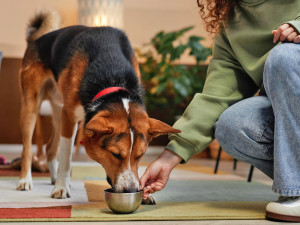How to Transition Your Dog’s Food
Follow this advice carefully.

Share Article
In This Article:
Should You Consider Switching Dog Food? How to Choose the Right Dog Food Switching at Life Stages Switching for Food Sensitivity Switching Weight Concerns Switching for Health Concerns How to Transition
Most of our pups eat the same exact food day in and day out, week after week, so it is important to remember that if you switch their diet, a sudden change can feel like a big shock to their (literal) system. While some dogs may handle a sudden diet change without any issues, others may experience digestive problems like bloating, gas, diarrhea, or refusal to eat. To avoid these unappealing consequences, most veterinarians recommend a very gradual diet transition over at least seven days. This way, the new food is slowly increasing in proportion every few days as the former diet is phased out.
It is important to watch for digestive issues like diarrhea or vomiting as well as any other physical or behavioral changes. If you suspect your dog is having a reaction linked to their new food, pause the transition and contact your vet. You may need to slow down the process or find a more suitable diet for your pup.

Should you consider switching dog food?
There are infinite reasons why you may be considering switching your dog’s food, and of course, infinite dog foods on the market that are vying for your interest. You may consider changing your dog’s diet because of health-related concerns, your dog’s age, pet-food costs, or your pup’s flavor preferences. Your veterinarian may also recommend a specific therapeutic diet as a way to help manage a medical condition.
Once you decide to go ahead and make the change, try to be strategic about introducing the new food during a time when you’ll be able to watch your dog more closely and no other big changes are happening. You’ll need at least a week’s time to make the transition.
How to choose the right dog food
With so many different kinds of dog foods on the market, it can feel impossible to know which food is best for your dog. The good news is that all dog foods that have an Association of American Feed Control Officials (AAFCO) statement of nutritional adequacy and are labeled as complete and balanced for daily nutrition have all of the nutrients your dog needs for a healthy diet.
If your dog has no medical conditions, picking a food may come down to factors like cost, how easy the food is to find in your area, if your dog likes the flavor, and whether it aligns with your values, such as sustainability or quality of ingredients. If your dog does have a medical condition, the choice may be largely influenced by the kinds of ingredients they need, or should avoid, as well as whether your vet recommends a specific prescription diet to support their treatment plan. In all cases, it is a good idea to consult with your vet if you have questions or concerns about what kind of diet to select for your dog.
Switching food at different life stages
One of the most common reasons to switch your dog’s food will come as they reach certain age milestones. Growing puppies have very different requirements than adult dogs, or pregnant dogs, or senior dogs. Some dog foods are labeled specifically for certain ages, while others may have a certification that they are appropriate for “all life stages.”
It is important to note that foods labeled for all life stages must meet the most nutritionally demanding life stages, so while they will provide adequate nutrients for all dogs, they may exceed what dogs need at certain stages. This can lead to weight gain or other health problems in some dogs. Some common milestones to consider are:
Transition from puppy to adult: Growing puppies have different nutritional requirements than adult dogs. This is most pronounced in large and giant-breed dogs that grow rapidly in the first one to two years of life. Once dogs are close to their adult size, usually around nine to 12 months for most dogs, or up to two years old for giant breeds, they should slowly transition to adult dog food.
Pregnant or lactating dogs: This is considered the most nutritionally demanding lifestage for dogs. Pregnant and lactating dogs typically need more calories and have a higher calcium demand than other dogs. It is very important to feed pregnant and lactating dogs an appropriate diet to avoid health complications.
Adult-to-senior transition: Dogs are considered seniors at varying ages, depending on their size. While giant breeds over seven are considered seniors, toy breeds don’t reach their golden years until they are closer to 10 or 11 years old, and medium-sized dogs fall somewhere in between. There are no specific requirements for a dog food to be considered senior dog food. Many brands formulate senior dog foods to be lower in protein, phosphorus, and sodium with higher fiber to account for common ailments of senior dogs. Not every senior dog needs these nutritional adjustments, however, so consult with your vet before selecting a senior dog food.
Switching for food sensitivity
Sometimes, you may need to consider a food change if your dog seems to be having a negative reaction to their current diet. This may include:
Allergies: Dogs with food allergies often show signs of itchy skin, recurrent ear infections, anal gland problems, or vomiting or diarrhea. Many times, a hypoallergenic diet can be used as part of their treatment plan. These are prescription diets that are specially formulated to be free of certain allergens.
Picky eater: Some dogs are finicky and may not like the taste or texture of certain dog foods. It may take some trial and error to find a food your dog likes.
Gastrointestinal problems: Other dogs may seem to have digestive issues like excessive gas, or diarrhea on certain kinds of diets but not on others. They may be sensitive to diets that are high in fat or fiber and may respond well to a diet that has a different composition.
Switching for weight concerns
A diet change may also be worth considering for dogs that need help maintaining a healthy weight. This can include:
Weight gain: Healthy weight gain is important for growing puppies, dogs that are underweight, dogs with certain medical conditions, and senior dogs that may be losing weight or muscle. These dogs may benefit from diets specifically formulated to be more calorie-dense so they can eat the same amount of food but take in more calories and nutrients in each serving.
Weight loss: Dogs who are overweight and need to lose weight may do best on a diet that is intended for weight loss. Often, these diets are higher in fiber and protein allowing dogs to feel full and satisfied while consuming fewer calories per serving. When transitioning to a high fiber diet it is especially important to use a very gradual introduction as fiber is hard to digest. Dogs that are not used to eating large servings of fiber may experience gas, bloating, or diarrhea from a sudden change.
Switching for specific health concerns
Many times, a dog’s medical condition will also necessitate a diet change. Therapeutic diets are often a highly effective way to manage certain conditions in combination with medical treatments and medications. These diets are almost always prescription diets; they must meet stricter requirements to prove their safety and efficacy. Since these diets are designed specifically for dogs with certain medical conditions, they are not always safe for healthy dogs to eat long-term as they may be intentionally lacking in certain nutrients. Dogs on these diets must be under close supervision from a veterinarian. Some common medical conditions that may require diet modifications include:
Heart disease: Dogs with advanced heart disease may need a diet that is lower in sodium to prevent fluid retention.
Kidney disease: Specialized kidney diets tend to be lower in protein and phosphorus with higher potassium. They may be useful for some dogs with kidney failure.
Urinary problems: Different diets may be used for dogs with conditions like bladder stones. Some diets can be used to dissolve certain kinds of stones, while other diets may prevent the recurrence of bladder stones.
Joint health: Dogs with advanced joint disease like arthritis need to maintain a healthy weight to avoid putting added pressure on their joints. They can also benefit from the anti-inflammatory properties of nutrients like essential fatty acids and joint supplements like glucosamine and chondroitin. Joint support diets may incorporate some or all of these ingredients directly into the food.
Diabetes: Diabetic dogs need to maintain a healthy weight and avoid spikes in blood sugar. Eating a diet that is higher in protein and fiber and lower in simple carbohydrates often helps stabilize their weight and blood-sugar.
Gastrointestinal disease: Dogs with various digestive conditions, including inflammatory bowel disease (IBD), food allergies, and/or pancreatitis may need specialized diets to help control their symptoms.
How to transition dog food
Once you have made the decision to switch your dog’s food, you may be wondering how to actually go about making the transition. Some general guidelines are:
Food transition schedule: The classic schedule for introducing a new diet takes about seven days. Start by mixing about one-quarter of the new food into their current diet at each meal for one to two days. If they seem to tolerate the new food without any problems, you can increase the proportion of the new food to one-half of each serving for the next two days. If all goes well, increase the amount of the new diet to three-fourths of each serving for another two days. If your dog seems to be eating well and not having any adverse signs, by day seven, you can feed the new food exclusively and complete the transition.
Risks of transition: The most common adverse sign of a diet change is digestive upset. Most dogs eat the exact same food for every meal consistently. When their diet is ultimately changed, it can take time for their digestive tract to adjust and some dogs develop gas, bloating, diarrhea, or a loss of appetite as a result. Some dogs may simply not like the taste of the new food, and this may lead them to eat less, or not eat at all. Finally, for dogs with suspected allergies, it is always important to be on the lookout for worsening signs of their allergies when a new food is introduced.
How to monitor: Monitor your dog’s appetite and weight in the first few weeks and months on a new diet. You’ll want to make sure your dog is still eating enthusiastically and that their weight does not change drastically in a short period of time. You’ll also want to watch for signs of digestive upset, like vomiting, diarrhea, or gas. If your dog is having signs of digestive upset, you may need to pause the transition or go even slower with the introduction of the new food to give your dog more time to adjust.
Consider probiotics: Depending on your dog’s health and the reason for the transition, a probiotic supplement may help ease digestive upset associated with a diet change. Probiotics provide beneficial microbes to the gut and can reduce inflammation and improve digestion. If your dog is on a very strict diet for certain health reasons, you’ll want to consult your vet before adding on a probiotic or any other supplements.
Bottom line:
There are many different reasons why a pet parent may need to change their dog’s diet including cost, flavor preference, their pup’s age, or specific medical needs.
Be sure to consult your vet if you are considering a diet change for health reasons; your dog may need closer monitoring or adjustments in their other treatments.
All diet changes should be performed very gradually to avoid digestive upset, and it should take at least a week to slowly transition your dog to a new diet.
References
“Association of American Feed Control Officials (AAFCO): Reading Labelsopens in new tab.” Accessed 11 April 2025.
Heinze, C. “Much ado about therapeutic dietsopens in new tab.” Tufts University Cummings School of Veterinary Medicine Petfoodology, 5 January 2017.
Herstad, K,et al. “A diet change from dry food to beef induces reversible changes on the faecal microbiota in healthy, adult client-owned dogsopens in new tab.” BMC Veterinary Research, vol. 13, no. 1, 13 May 2017, pp. 147.
Korinn, E., “Nutritional concerns for cancer, cachexia, frailty, and sarcopenia in canine and feline petsopens in new tab.” Veterinary Clinics of North America Small Animal Practice, vol. 51, no. 3, May 2021, pp. 729-744.
Watson, A, et al., “A novel therapeutic diet can significantly reduce the medication score and pruritus of dogs with atopic dermatitis during a nine‐month controlled studyopens in new tab.” Veterinary Dermatology, vol. 33, no. 1, 20 September 2021, pp. 55-e18.

Dr. Amy Fox, DVM
Amy Fox, DVM is a small animal veterinarian in New York City with over thirteen years of experience in a mixture of general practice, emergency medicine, and shelter medicine. A lifelong animal lover, Dr. Fox studied biology in college and then worked as a veterinary nurse before pursuing veterinary school at Cornell University. Her expertise includes surgery, dentistry, and management of chronic conditions, and she is interested in toxicology, pain management, nutrition, care of senior pets, and educational outreach. Dr. Fox also enjoys writing about veterinary medicine and teaching, and her work has previously appeared in Spruce Pets. In her free time, she loves to cook, garden, go for long runs, and hang out with her goofy mixed-breed dog May, who provides never ending comic relief!
Related articles
Can Puppies Eat Adult Dog Food?
They might want to hurry up and be a big kid, but here’s why it’s good to wait.
![German Shepherd puppy pulling at a branch]()
Dog Life Stages: Puppy Adolescence Is Only a Phase
What to expect when your perfect puppy hits that unruly stage.
![Woman measuring dog food with scale]()
Should You Put Your Dog on a Low-Calorie Diet?
Diet culture is a tricky thing — for pets, too.
![Woman petting her dog outside in the grass.]()
How to Tell If Your Dog Is Pregnant
And what to look for week by week.
![Woman making dinner for her dog at home.]()
Best Food for Dogs With Allergies
Because no one deserves to be uncomfy.
![Young female veterinarian in her consulting room performing a medical examination on a dog for diabetes]()
How to Spot, Treat, and Prevent Diabetes in Your Dog
Learn which breeds are at risk, the symptoms to look out for, and what treatment options are available.








